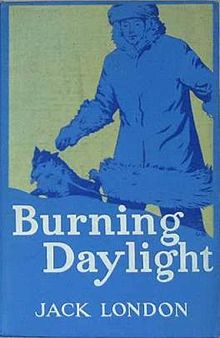Call of the gold
Lockruf des Goldes , also published as Goldrausch and Lockendes Gold , English original title Burning Daylight , is a 1910 novel by the American writer Jack London (1876-1916). It was his most successful and best-selling book during his lifetime in London.
content
The action begins in 1893 during the so-called gold rush in the Yukon Territory , Canada . Among his colleagues, the protagonist Elam Harnish, nicknamed Burning Daylight, is considered to be the most successful gold prospector who succeeds in finding an outstanding gold in the course of the plot. Elam Harnish becomes a mine owner and rises to an enterprising entrepreneur who ultimately goes on the New York Stock Exchange and is confronted with an attitude towards life that is contrary to his previous environment: inhumanity and cruelty. Finally he turns his back on the side of his former secretary of this world and moves with her to a ranch.
Publication history
London began writing the novel in Quito in 1909 , shortly before he returned to California. The preprint in the New York Herald ran from June 19, 1910 to August 28, 1910 . Although the book edition Lockruf des Goldes was only published in October 1910, 164,000 copies had already been sold by the end of the year. This success made the novel one of the bestsellers of the year.
backgrounds
Parts of the figure are based on both the Oakland entrepreneur Borax Smith and the gold prospector Elam Harnish (1867–1941), whose name served not least as a model for London's protagonists. Harnish was ten years older than Jack London and traveled to Yukon in 1897, where he and London met. When London became seriously ill, he was sent home by Harnish in 1898, who continued to try his hand at prospecting and logging. Harnish was considered to be extremely strong and tenacious, but unlike the character in the novel, he never achieved great wealth. As the Russian literary scholar and translator Vil M. Bykow describes, Harnish is said to have actually read Lockruf des Goldes : "In his opinion, the book was like the weather in the north: sometimes great, sometimes terrible." Bykov also writes: "He was pleased that Jack London remembered him after twelve years, but that the hero of the book would end up being a rich man, he was very upset."
Film adaptations
All in all, Lockruf des Gold was filmed four times in the USA. 1914 by Hobart Bosworth , 1920 by Edward Sloman , 1928 by Charles Brabin , 2010 by Sanzhar Sultanov. In 1975 an adventure four-parter was broadcast on German television.
expenditure
First edition
- Burning daylight . Macmillan, New York 1910 ( digitized version ).
Translations into German
- Call of the gold . Translated by Erwin Magnus. Grethlien & Co., Leipzig 1926.
- Gold rush . Translated by Eduard Thorsch. Swiss printing and publishing house, Zurich 1947.
- Alluring gold . Translated by Horst Höckendorf, with an afterword by Karl-Heinz Wirzberger . Aufbau-Verlag, Weimar 1967.
- Call of the gold . Newly translated with an afterword, notes and a timetable by Lutz-W. Wolff. dtv , Munich 2015, ISBN 978-3-423-14426-1 (first complete translation into German).
Individual evidence
- ↑ See Lutz-W. Wolff in his epilogue The Greatest Game of His Life to his new translation of Lockruf des Goldes . Munich 2015 (dtv), ISBN 978-3-423-14426-1 , p. 383.
- ↑ See Wolff: Afterword, p. 383.
- ↑ See Wolff: Afterword, p. 383.
- ↑ See Wolff: Afterword, p. 384 .; See Russ Kingman: A Pictorial Life of Jack London . New York 1979 (Crown)
- ^ Georg Herbert Hildebrand: Borax Pioneer. Francis Marion Smith. San Diego 1982 (Howell-North Books), ISBN 0-8310-7148-6
- ↑ The information on Harnish follows Wolff (afterword, p. 385), who in turn refers to Vil M. Bykow
- ↑ See Internet Movie Data Base entry Burning Daylight (1914)
- ↑ See Internet Movie Data Base entry Burning Daylight (1920)
- ↑ Cf. Internet Movie Data Base entry Lockruf des Goldes (1928)
- ↑ See Internet Movie Data Base entry Burning Daylight (2010)
